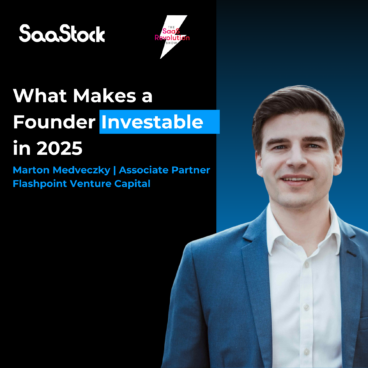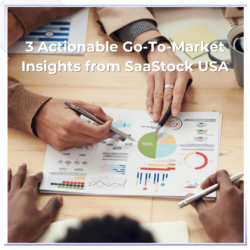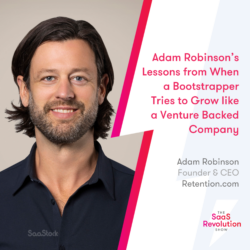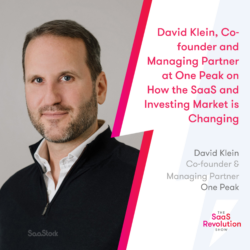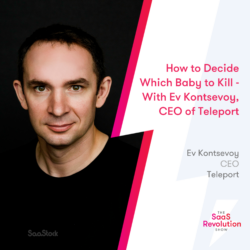In this episode of the SaaS Revolution Show our host Alex Theuma is joined by Marton Medveczky, Associate Partner at Flashpoint Venture Capital, who shares what exactly makes a founder investable in 2025.
“There is always a huge difference between talking to the founder and then doing your own desktop research versus talking to a customer. So if you can do that, that’s basically the best way to understand what people value about the product. And it also will help you to draw further conclusions about where to look or, like, what is actually the real paper that it solves. And oftentimes it’s actually not what the founders think it is, right? Which is very funny, I think. And that’s why customer calls are sort of like a super vital component for us to invest.”
Marton shares:
- The key characteristics he looks for in a founder before investing
- Nailing value propositions and pain points: the one thing founders *need* to be doing
- What the next 12 months look like and if fewer companies are moving into venture
- How his initial VC journey started versus what it looks like now
- Winning the market and becoming a category leader: what can SaaS companies do to succeed?
- Why net revenue retention is the most important metric
Watch the full episode below or read on for key takeaways:
Listen to the audio now:
Last year, global VCs invested $370 billion across 35,000+ deals; with almost three-quarters spent in the US ($209 billion) and Europe ($62 billion).
Amidst continuing economic uncertainty, SaaS investors focused on established scale-ups over riskier start-ups. In Europe, 65% of funding was allocated to Series C+ companies (up from 38% in 2023) and Series A funding was down 34% in the first half of the year.
But with economic conditions expected to improve in 2025, what are VCs looking for this year?
Speaking on the SaaS Revolution Show at the end of last year, Marton Medveczky, Associate Partner at tech-focused Flashpoint Venture Capital talked through the firm’s approach—here are the highlights:
Strong founder compatibility
“Venture investment is like a marriage and tends to last longer than the average marriage.”
For Marton, the biggest failure in his early career was investing in companies without considering the founders. Now though, personal chemistry between the VC and the founder is “probably the most important part of venture investment”.
Flashpoint will therefore assesses the Founder-CEO fit using classic psychological evaluation tools. In addition, they use LLMs to analyse founder conversations and categorise founders into various models (i.e. the DISC model) based on their characteristics. The most valued attributes? Founders who are more assertive and aggressive, and very eager to achieve their goals.
Companies with an efficiency edge
“The core idea at Flashpoint is [that] we want to invest in companies with an efficiency edge.”
Unsurprisingly, Flashpoint invests in companies that are very capital efficient. This includes looking for companies selling to global markets but with their backend or engineering teams located in countries with lower labour costs, such as Central and Eastern Europe.
According to Marton, this creates a very favourable effect on P&L, which allows the company to raise less money. Or, if the company raises more money, it can spend more on marketing or become profitable much sooner.
Companies with strong GTM potential
“The hardest thing is the go-to-market. Unless you have an inherent virality in the product, it’s just very hard to penetrate the noise nowadays.”
Marton likes investing in companies with a GTM that is mostly SEO driven, product-driven or uses good quality content as this shows you’re not spending much money to attract new customers. But, the most important GTM consideration pre-investment is the market size and customer feedback.
Firstly, a large market, so even if you’re not successful with your first GTM motion, you have many other ways to penetrate the market (and hopefully your product is good enough that it will then expand the market). Secondly, if Flashpoint likes what it sees, they have reference calls with customers to better understand what people value about your product and the actual pain point it solves. As Marton notes: “there’s always a huge difference between talking to the founder versus talking to a customer. Often, the pain point is not what the founders think it is, so that’s why customer calls are a super vital component for us to invest.”
Companies that hit the right metrics (especially NRR)
“If you have a product that currently sells well and all the other metrics make sense, then it shows the product is great.”
In general, Flashpoint looks for SaaS companies with high net revenue retention (NRR), low logo churn, and high ARR growth. At Flashpoint’s investment ‘sweet spot’ (companies with $1.5-2 million ARR), the key ‘investable metrics’ include:
- ICP churn. Are you selling to your true ICP? What’s your churn with this particular customer group? If you’re selling to mid-market or enterprise customers, churn for these customers shouldn’t exceed 20% per year.
- Growth rate. At around $1 million ARR, Flashpoint is aiming for a 3x growth rate (or at least a 2x growth rate with signs showing growth is blocked by a lack of money).
- Efficiency. Flashpoint looks at the magic number to evaluate efficiency, but also the levels of previous fundraising. If you’ve raised $5 million, but only achieved $1 million ARR, it likely means you’re not very efficient or investable. Ideally, they want your revenue-to-raised amount to be close to one.
However, Marton told me the most important metric is net revenue retention. “It shows the quality of the product, the quality of the sales (if you’re selling to the right type of customers) and whether the product has room for expansion within those customers.”
What’s an investable NRR in 2025? For Flashpoint, it’s between 120-130%, so you grow 30% next year by doing nothing.
Meet your next investor at SaaStock USA
There’s a lot to it but a big part of the process, as Marton said, is that founder-investor fit. And that means meeting the right investor and building that relationship. That’s why, at SaaStock USA, we’ll have a core focus on networking and connecting founders with investors who can help move their business forward–through our networking program, global pitch competition, and more.
